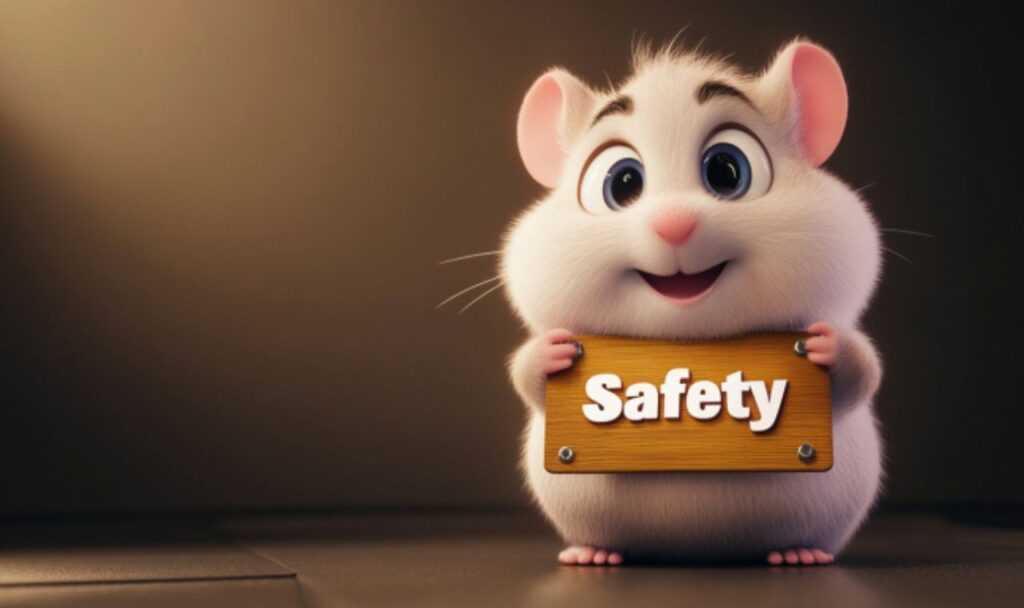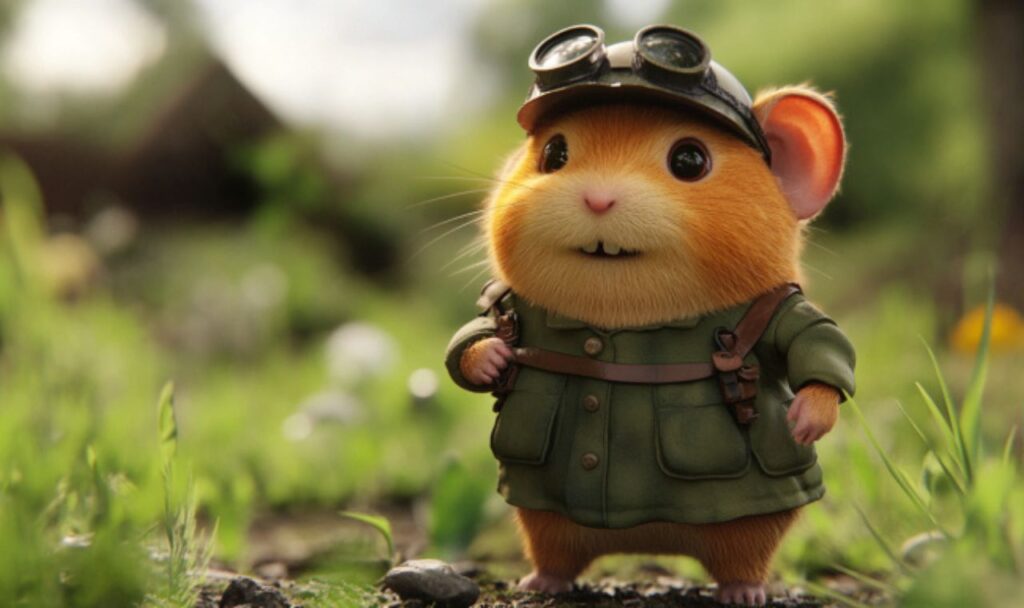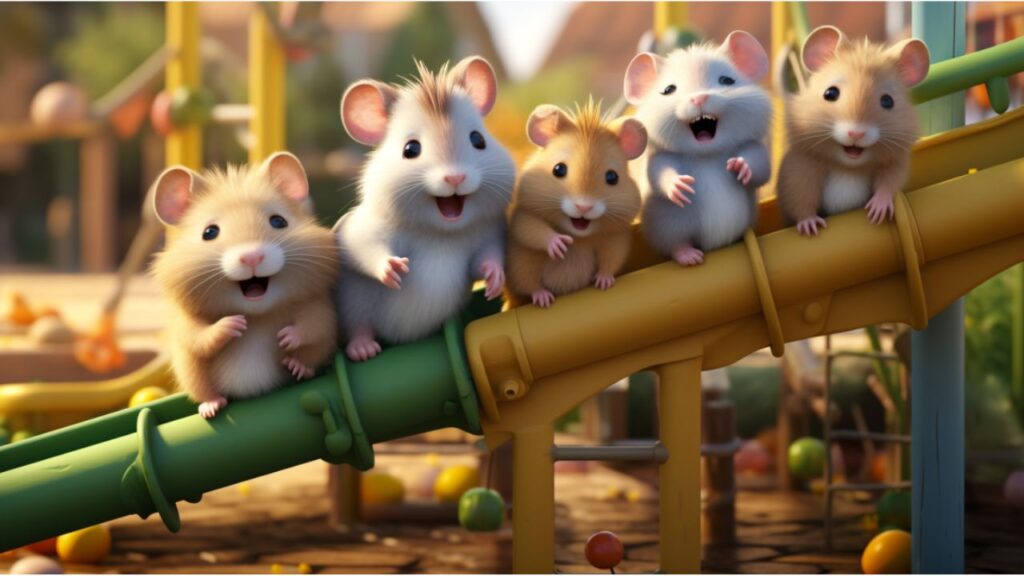Hamsters may be small, but their personalities are anything but! Some are naturally bold and curious, while others are shy and skittish. If your hamster darts away when you approach, hides at the slightest movement, or even nips when you try to handle them, don’t worry—you’re not alone. Many new hamster owners experience this, and with patience, the right approach, and consistent socialization, even the most nervous hamster can learn to trust you.
Why Are Some Hamsters Skittish?
There are several reasons why a hamster might be more timid than others. Some of these factors are simply part of their nature, while others are influenced by past experiences:
- Species Differences – Syrian hamsters tend to be more confident, while dwarf species, like Roborovskis, are naturally more skittish and difficult to handle.
- Genetics – Just like people, some hamsters are born with a more anxious temperament.
- Early Life Experiences – Hamsters that come from pet stores often experience rough handling and stressful environments, making them wary of human interaction.
- Environmental Factors – Loud noises, sudden movements, or even a lack of proper hiding spots can contribute to stress and skittish behavior.
Why Socialization is Important for Your Hamster
Socialization is the process of gently introducing your hamster to human interaction in a way that makes them feel safe and comfortable. A well-socialized hamster is not only easier to handle but also happier and less prone to stress-related health issues. Here’s why socialization is essential:
- Reduces Fear and Anxiety – A hamster that trusts its owner will feel more secure in its environment, leading to a more relaxed pet.
- Prevents Biting and Defensive Behaviors – Skittish hamsters often resort to biting out of fear. Proper socialization minimizes this behavior.
- Strengthens the Bond Between You and Your Hamster – Socialization helps your pet associate you with positive experiences, making interactions enjoyable for both of you.
What You’ll Learn in This Guide
In this article, we’ll walk you through:
✔ Understanding why some hamsters are more nervous than others
✔ Creating a stress-free environment for socialization
✔ Step-by-step techniques for gentle handling
✔ How to overcome setbacks like biting or regression
✔ Long-term strategies to strengthen your bond
By the end of this guide, you’ll have all the tools you need to turn your skittish hamster into a trusting, happy companion. Let’s get started! ✨
Understanding Skittish Hamsters

Before you can successfully socialize a skittish hamster, it’s important to understand why some are more nervous than others. A hamster’s temperament isn’t random—it’s shaped by a mix of genetics, past experiences, and environmental factors. By recognizing what makes your hamster wary and learning to read their behavior, you’ll be able to approach socialization in a way that makes them feel safe rather than threatened.
Why Are Some Hamsters More Nervous?
Some hamsters are naturally more anxious than others, and a big part of this comes down to their species. Syrian hamsters, which are larger and more solitary, tend to be more confident and easier to tame. Dwarf hamsters, including Roborovskis, Campbell’s, and Winter Whites, are much smaller and faster, making them more prone to skittishness. Roborovskis, in particular, are known for being incredibly difficult to handle due to their high energy and natural wariness. Even within the same species, individual personality differences and genetics play a role—some hamsters are simply born more cautious than others.
A hamster’s early life experiences also impact how they respond to humans. Many pet store hamsters come from large-scale breeding operations where they have little to no positive human interaction. They may have been housed in overcrowded conditions, handled roughly, or exposed to constant stress before arriving in their new home. These experiences can make them naturally distrustful of people, requiring extra patience and gentle socialization.
Even a hamster with a calm temperament can become skittish if their environment feels unsafe. Loud noises, sudden movements, and frequent disruptions can all contribute to anxiety. A hamster that lacks proper hiding spots or lives in a cage that is too small may also feel constantly on edge. Their instincts tell them to be cautious, as they are prey animals in the wild, and any perceived threat can trigger a fearful response.
Signs of a Skittish Hamster
Recognizing the signs of a nervous hamster is crucial to understanding their comfort level. One of the most common behaviors is freezing in place when they detect movement nearby. This is a natural defense mechanism, allowing them to assess whether they are in danger. If they feel unsafe, they may quickly run and hide in their tunnels or burrow deep into their bedding. Some hamsters will only come out when they think no one is watching, which is a clear sign that they don’t yet feel secure in their environment.
In more extreme cases, a skittish hamster may react defensively. If they feel cornered, they might squeak loudly, chatter their teeth, or even bite when approached. This isn’t out of aggression but rather fear. A hamster that has not yet learned to trust human hands may try to nip as a warning to back off. Over time, with gentle handling and patience, this behavior can often be reduced or eliminated.
Some hamsters remain hesitant to interact even after prolonged exposure to their owner. While a well-socialized hamster will usually begin to recognize and approach their owner over time, a persistently skittish hamster will continue avoiding contact. If they always retreat when you enter the room or refuse to take treats from your hand, they may still view humans as a potential threat.
Why Socialization is Essential
Helping a skittish hamster overcome their fear isn’t just about making them easier to handle—it’s about improving their overall well-being. A hamster that feels safe and comfortable in its environment will be less stressed, healthier, and ultimately happier. Socialization teaches your hamster that human interaction doesn’t have to be scary, helping to replace fear with trust.
Reducing stress is particularly important because chronic anxiety can lead to health problems. A hamster that is constantly on edge may develop a weakened immune system, digestive issues, or excessive grooming habits that result in fur loss. By gradually introducing positive experiences, you help your hamster feel more secure, which in turn promotes their physical health.
Beyond reducing stress, socialization strengthens the bond between you and your pet. A hamster that trusts its owner will willingly approach, take treats from your hand, and even enjoy gentle handling over time. Even if your hamster never becomes fully hand-tame, the goal of socialization is to ensure that they feel safe and comfortable in their home. The more positive interactions they have, the more likely they are to associate you with safety rather than fear.
Now that you understand why some hamsters are naturally more nervous and why socialization is important, the next step is to create an environment that encourages trust. Making sure your hamster feels safe in its surroundings is the foundation for a successful socialization process.
Creating a Safe Environment for Socialization

Before you even attempt to handle a skittish hamster, you need to ensure that their living space promotes a sense of security. A hamster that feels safe in its environment is much more likely to trust you over time. This means choosing the right cage setup, using scent as a trust-building tool, and maintaining a predictable routine. These small but important factors help reduce fear and lay the foundation for successful socialization.
Setting Up a Stress-Free Cage
The right cage setup plays a huge role in how comfortable and secure your hamster feels. If their environment is too small, too exposed, or too noisy, they may remain constantly on edge, making socialization difficult.
A proper hamster cage should be spacious enough to allow natural behaviors like burrowing, running, and hiding. A single Syrian hamster needs at least 450 square inches of unbroken floor space, while dwarf species thrive in a similar setup but can manage with slightly smaller enclosures. Many commercial cages marketed for hamsters are far too small, leading to stress and even behavioral issues like bar biting. Large glass tanks or DIY bin cages provide a safe, escape-proof space where a hamster can feel secure.
Just as important as cage size is the layout. Hamsters rely on hideouts and tunnels to feel safe, so their cage should include plenty of hiding spaces, wooden houses, tunnels, and deep bedding (at least six inches for burrowing). A hamster that has access to proper hideouts will feel much less exposed and more confident in exploring their environment. If they feel like they always have a safe retreat, they will be more likely to come out when you’re around.
Another major factor in reducing stress is keeping the environment calm and predictable. Hamsters have sensitive hearing and are easily startled by loud noises, so placing their cage in a quiet area of your home—away from TVs, loud music, and household traffic—can make a huge difference. Avoid sudden movements when interacting with them, especially in the first few weeks. In the early stages of socialization, it’s best to limit excessive handling and allow your hamster to adjust to their new home before attempting direct interaction.
The Role of Scent in Trust-Building
Hamsters rely heavily on their sense of smell to recognize what is familiar and safe. You can use this to your advantage when socializing a nervous hamster by introducing your scent in a non-threatening way.
One of the easiest methods is to place a small tissue or piece of fabric with your scent inside the cage. Rubbing a tissue between your hands and leaving it in their enclosure allows your hamster to become accustomed to your smell without direct interaction. Over time, they will start associating your scent with something familiar rather than something to be afraid of.
Another effective technique is allowing your hamster to explore your scent gradually. Instead of immediately trying to pick them up, place your hand inside the cage without moving it. Let your hamster come to you at their own pace. At first, they may sniff your hand briefly before scurrying away, but with patience, they will grow more comfortable. Never force interaction—let them take the lead in this process.
It’s also important to be mindful of strong scents on your hands, as hamsters can be sensitive to unfamiliar smells. Avoid using strong-smelling soaps, lotions, or perfumes before handling your hamster, as these can be overwhelming and make them hesitant to approach you. Washing your hands with unscented soap before interactions helps keep your scent consistent and recognizable to them.
The Importance of Routine and Predictability
Hamsters thrive on routine. In the wild, they follow a consistent schedule for foraging and exploring, and you can use this natural instinct to your advantage when socializing a nervous hamster. By establishing a daily routine, you create a predictable and reassuring environment, helping your hamster feel more secure.
One of the best ways to build trust is by feeding and handling your hamster at the same time every day. If they know when to expect food, they will begin to associate your presence with something positive. This routine also helps regulate their sleep-wake cycle, making them more likely to be active and receptive to interaction during specific times. Offering food by hand can further reinforce this bond, as they will start recognizing you as a provider of good things.
When it comes to handling, it’s best to keep interactions short and positive in the beginning. Instead of overwhelming your hamster with long handling sessions, start with brief interactions that end on a good note. Even just spending a few minutes sitting by their cage and speaking softly can make a difference. Over time, these small moments of positive interaction add up, helping your hamster feel more comfortable around you.
Observing your hamster’s body language is also key. Recognizing when your hamster is receptive to handling will make socialization much easier. If they seem relaxed, come to the front of the cage, or sniff your hand without hesitation, they are likely open to interaction. However, if they are startled, hiding, or showing defensive behavior like chattering their teeth, it’s best to give them space and try again later.
By setting up a stress-free cage, using scent to build trust, and maintaining a predictable routine, you create the ideal environment for successful socialization. A hamster that feels safe is much more likely to become comfortable with you over time. The next step is learning how to gently handle them in a way that reinforces trust rather than fear.
Gentle Handling Techniques for Socialization

Once your hamster feels secure in their environment, the next step is introducing gentle handling in a way that builds trust rather than fear. Rushing this process can cause setbacks, so it’s important to take things slowly and allow your hamster to adjust at their own pace. Socialization should always be a positive experience, and the key is to make your hamster feel like they are in control of interactions.
The Hands-Off Approach at First
When socializing a skittish hamster, the biggest mistake new owners make is trying to handle them too soon. Unlike dogs or cats, hamsters don’t instinctively crave human touch, so you need to earn their trust before attempting direct interaction. The best way to start is by letting your hamster get used to your presence without any physical contact.
Begin by simply spending time near their cage. Sit beside them quietly, allowing them to observe you without feeling threatened. Avoid sudden movements, and don’t hover over the cage, as this can mimic a predator’s approach. Instead, position yourself at their level so they can see you as a part of their environment rather than something to fear.
Talking softly near the cage also helps build familiarity. Hamsters have excellent hearing and can distinguish sounds over time. Speaking in a calm, gentle voice while you sit by the cage allows your hamster to associate your voice with safety. You might notice that after a few days, they become less reactive to your presence and may even start coming out when they hear you.
Most importantly, allow your hamster to come to you instead of forcing interaction. Never chase them around the cage with your hand, as this can cause stress and set back your progress. Instead, wait until they show signs of curiosity—like approaching the cage bars or sniffing the air when you’re nearby—before attempting any further steps.
Using Treats to Encourage Trust
Food is one of the best tools for socializing a hamster, as it creates a positive association with your presence. By offering safe hamster treats from your hand, you can slowly teach your hamster that interacting with you leads to good things.
Start by placing a treat inside the cage without attempting to touch them. Choose a high-value treat that your hamster finds irresistible, such as a small piece of unsalted sunflower seed, a mealworm, or a tiny bit of fresh fruit (like apple or banana). After a few days, try holding the treat in your open palm near the entrance of their hideout. If your hamster is comfortable, they may cautiously approach and take the treat from your hand.
Whenever your hamster exhibits calm behavior—such as sniffing your hand or taking food without hesitation—reward them with positive reinforcement. This can be as simple as offering another treat, speaking to them gently, or just remaining still so they don’t feel pressured. The goal is to show them that approaching you is always a safe and rewarding experience.
However, it’s important to avoid overfeeding. If you give treats too frequently, your hamster may lose interest in interacting with you since they’ll already be full. Instead, use treats strategically during socialization sessions to maintain their motivation and curiosity. Treats should be an occasional reward, not a bribe, ensuring that your hamster’s trust is built on more than just food.
Gradual Hand Taming Process
Once your hamster consistently takes treats from your hand, you can begin the gradual process of hand taming. The key here is patience—some hamsters will adjust quickly, while others may take weeks to become comfortable with direct handling.
Start by introducing your hand slowly into the cage. Move at a relaxed pace and place your hand palm-up on the floor of the enclosure. Keep it still and let your hamster explore it on their own terms. At first, they may sniff your fingers and then retreat, but over time, they will begin to associate your hand with safety.
As your hamster grows more comfortable, they may start climbing onto your hand voluntarily. Avoid lifting them right away—let them get used to the feeling of standing on your hand first. You can reinforce this behavior by keeping a treat in your palm, encouraging them to explore further.
When your hamster willingly steps onto your hand, you can progress to gentle lifting. Raise your hand slightly off the ground for just a few seconds before setting them back down. Gradually increase the duration of these handling sessions while always paying attention to your hamster’s body language. If they show signs of stress, such as jumping off quickly or trying to escape, slow down and return to the previous step.
By following this gradual approach, you’ll develop a trusting relationship with your hamster, making handling a natural and stress-free experience for both of you. The next step is learning how to deal with setbacks, such as biting or regression, so you can continue progressing even when challenges arise.
Overcoming Setbacks in Socialization

Even with the best approach, socializing a skittish hamster isn’t always a smooth journey. Setbacks are common, especially when dealing with naturally timid or easily startled pets. Some hamsters may suddenly start biting after showing progress, while others might regress and become more fearful after a stressful event. Understanding why these setbacks happen and how to handle them properly is key to continuing your hamster’s socialization journey without losing progress.
Handling a Hamster That Bites
Biting is one of the most frustrating setbacks for hamster owners, but it’s important to remember that hamsters rarely bite out of aggression. Instead, biting is a defensive reaction—your hamster is trying to tell you that they feel threatened or uncomfortable. The first step in addressing this behavior is understanding why biting happens in the first place.
A hamster may bite due to fear, sudden movements, or being startled by unfamiliar scents. If they feel cornered or forced into interaction, biting becomes their only way to defend themselves. Some hamsters also bite if they associate hands with stress or past negative experiences, such as rough handling at a pet store. Additionally, if your hands carry the scent of food, your hamster might mistakenly nibble, thinking you have something tasty to offer.
To prevent biting, avoid sudden movements and respect your hamster’s boundaries. Never grab or chase them around the cage, as this will only reinforce their fear. Instead, let them come to you at their own pace. When placing your hand in the cage, move slowly and keep it still, allowing them to sniff and explore without pressure. If your hamster shows signs of stress—such as flattening their body, chattering their teeth, or backing away—it’s best to stop and give them space.
If a bite does happen, reacting calmly is crucial. Instinctively pulling your hand away or making a loud noise can startle your hamster further and reinforce the idea that biting is an effective way to make you retreat. Instead, try to remain still and gently blow a small puff of air toward them to discourage biting. Never punish or yell at your hamster, as this will only create more fear. Over time, as trust builds, biting behavior usually decreases.
Dealing with Regression in Behavior
Even if your hamster has made progress, there may be times when they suddenly become more fearful or hesitant to interact. This regression in behavior is completely normal and often happens when a hamster experiences a stressful event, such as a cage cleaning, a new environment, or an unfamiliar scent in their space. If your hamster suddenly starts hiding more or avoiding interaction, it’s likely that something in their surroundings has triggered stress.
The best way to handle regression is to identify the stress trigger and give your hamster time to readjust. If you recently deep-cleaned their cage, rearranged their layout, or moved them to a new room, their sudden nervousness may be a reaction to these changes. Hamsters rely heavily on scent to feel secure, and removing all their familiar smells can make them feel vulnerable. In such cases, allowing them a few days to settle before resuming socialization is beneficial.
If your hamster’s behavior has regressed, reverting to earlier socialization steps can help rebuild their confidence. Instead of jumping right back into handling, go back to sitting near the cage, speaking softly, and offering treats from your hand. This reminds your hamster that your presence is safe and predictable.
Patience and consistency are key during these moments. Some hamsters take longer to recover from stress, but as long as you continue reinforcing positive interactions, they will gradually regain trust. Avoid getting discouraged—socialization is a long-term process, and setbacks are just part of the journey.
When to Give Your Hamster More Space
While most hamsters can be socialized to some degree, not every hamster will become fully hand-tame, and that’s okay. Just like people, hamsters have unique personalities—some are naturally more independent and prefer minimal handling. The key to successful socialization is knowing when to push forward and when to step back.
A hamster that is overwhelmed may show signs of stress, such as hiding more than usual, freezing in place, or trying to escape when approached. If your hamster consistently avoids contact despite weeks of gentle interaction, they may need more time and space to feel secure. Forcing socialization when they are not ready can do more harm than good, leading to increased fear rather than trust.
It’s perfectly fine to allow rest days between handling sessions, especially for highly anxious hamsters. If your hamster seems stressed after a socialization attempt, give them a break and try again later. Some hamsters benefit from a few days of hands-off interaction, where you simply sit near their cage and let them observe you without pressure.
Ultimately, accepting that some hamsters will always be more independent is an important part of being a responsible owner. While some may become comfortable with handling, others may prefer limited interaction, such as taking treats from your hand but not being picked up. The goal of socialization is to ensure your hamster feels safe and happy, even if that means respecting their preference for less handling.
By recognizing setbacks as part of the socialization process and adjusting your approach accordingly, you can continue building trust with your hamster at a pace that suits their comfort level. The most important thing is to create a bond based on patience and mutual respect, allowing your hamster to interact with you in a way that feels safe for them.
Strengthening the Bond Over Time

Building trust with a skittish hamster doesn’t stop once they’re comfortable with handling. Strengthening the bond requires ongoing positive interactions that make your hamster feel safe, engaged, and happy in your presence. By providing enriching playtime outside the cage, introducing simple tricks for mental stimulation, and respecting your hamster’s personality, you can create a long-term, trusting relationship.
Playtime Outside the Cage
Once your hamster is comfortable with your presence and gentle handling, allowing them supervised playtime outside the cage can be a great way to deepen your bond. A safe, enclosed play area gives your hamster the freedom to explore while still feeling secure.
One of the best places for out-of-cage playtime is a dry bathtub lined with soft bedding and toys. The high, slippery walls prevent escapes while providing a controlled space for exploration. If a bathtub isn’t available, a large, secure playpen can also work. It’s important to choose an enclosure with solid walls, as wire barriers may allow small hamsters (especially dwarfs) to slip through.
During playtime, you can introduce toys, tunnels, and hideouts to encourage natural behaviors like burrowing and climbing. Cardboard boxes, wooden bridges, and paper towel tubes make great interactive elements. You can also place your hand in the play area and let your hamster climb on you voluntarily, reinforcing trust in a relaxed, open space.
If your hamster enjoys roaming, you can gradually introduce supervised free-roaming time in a hamster-proofed area. Make sure there are no open gaps, electrical wires, or small spaces where they could hide and become stuck. Always supervise these sessions closely, as hamsters are quick and can disappear into tiny spaces in seconds!
Teaching Simple Tricks for Engagement
Training your hamster isn’t just a fun party trick—it’s an excellent way to build trust and provide mental stimulation. Hamsters are smart and can learn simple tricks through positive reinforcement, which strengthens their bond with you.
One of the easiest tricks to teach is target training, where your hamster learns to follow an object, such as a small stick or your finger, in exchange for a treat. Start by holding the target close to their nose and rewarding them with a treat when they sniff or touch it. Gradually, you can encourage them to follow the target for longer distances, eventually leading them through tunnels or up ramps.
Another great way to engage your hamster is by encouraging climbing and exploring with rewards. If your hamster enjoys climbing, you can set up small obstacles like low platforms or ramps and reward them for successfully navigating them. Placing treats at the end of a tunnel or inside a hideout can also encourage natural foraging behaviors while reinforcing their confidence in interacting with their environment.
The key to successful training is patience. Always keep sessions short and positive, using small treats as motivation. If your hamster loses interest, don’t force it—simply try again another time when they seem more active and curious.
Long-Term Trust and Companionship
Every hamster has a unique personality, and long-term bonding means recognizing and respecting their individual comfort levels. Some hamsters will become very social and enjoy interacting with you regularly, while others may always prefer more independent exploration with minimal handling. Understanding and accepting these differences is essential for maintaining a positive relationship with your pet.
As your hamster grows more comfortable, you can adjust your handling techniques to suit their preferences. If they enjoy sitting in your hands, you can practice holding them for longer periods. If they prefer to explore independently, you can interact with them through playtime rather than extended handling. The goal is to ensure that every interaction is a positive one, reinforcing the trust you’ve worked so hard to build.
Most importantly, celebrate the small victories. Every milestone—whether it’s your hamster taking a treat from your hand, climbing onto you willingly, or simply showing curiosity instead of fear—is a step forward. Socialization is a gradual process, and progress may not always be linear. Some days your hamster may be more confident, while other days they might be hesitant. That’s completely normal.
By consistently providing a safe, enriching environment and respecting your hamster’s boundaries, you’ll develop a lasting bond based on trust and companionship. Even if your hamster never becomes fully hand-tame, the most important thing is that they feel safe and happy in their home—with you as a trusted presence in their world.
Hannah’s Training Tactics

Socializing a skittish hamster takes patience, consistency, and a gentle approach. To make the process easier, here are some quick and effective training tactics to help you build trust and strengthen your bond.
Start Slow—Let Your Hamster Adjust Before Handling
The first few days in a new home are overwhelming for a hamster. They need time to explore their cage, establish their burrowing spots, and adjust to unfamiliar sights, sounds, and smells. Before attempting any handling, give your hamster at least 3 to 7 days to settle in. During this time, avoid unnecessary disturbances and simply observe their behavior.
Once they start coming out of their hideouts more comfortably, begin passive socialization by sitting near their cage and talking softly. This helps them get used to your presence without feeling threatened. Moving too quickly—such as reaching in and trying to pick them up right away—can cause unnecessary stress and slow down the bonding process.
Use Treats Strategically to Encourage Positive Interactions
Treats are one of the best tools for hamster training, but they should be used strategically. Instead of offering food randomly, use it as a way to reinforce trust and encourage interaction. Start by placing a small treat inside the cage and gradually work up to offering it from your hand.
Choose high-value treats like sunflower seeds, dried mealworms, or small fruit pieces, as these are more enticing than regular food. Always let your hamster approach you rather than forcing a treat in front of them. If they hesitate, be patient and try again later. Over time, they will associate your hand with positive experiences and begin approaching more confidently.
To keep your hamster motivated, avoid overfeeding treats. If they have unlimited access to tasty snacks, they may lose interest in interacting with you. Instead, offer treats in moderation and only during socialization sessions to maintain their curiosity and engagement.
Stick to a Routine to Make Your Hamster Feel Secure
Hamsters thrive on predictability, and following a consistent routine helps them feel more comfortable. Try to feed, interact, and handle your hamster at the same time each day, as this creates a sense of structure and allows them to anticipate when socialization will occur.
Since hamsters are nocturnal or crepuscular (most active at dawn and dusk), aim for socialization sessions during their natural wakeful periods. Interacting with them when they are sleepy or groggy can lead to frustration and resistance. Observe their activity patterns and engage with them when they seem the most alert and curious.
By maintaining a steady routine, your hamster will learn to expect and trust your presence, reducing anxiety and making handling easier over time.
Never Force Handling—Respect Your Pet’s Boundaries
One of the most important rules in hamster socialization is never to force interaction. If your hamster is hiding, freezing in place, or showing defensive behaviors (such as chattering their teeth or trying to escape), it means they are not ready for handling. Pushing them beyond their comfort zone will only create fear and may lead to biting or regression.
Instead, allow your hamster to set the pace. If they seem hesitant, go back to earlier steps, such as hand-feeding or sitting near their cage. Some hamsters may take days to warm up, while others may take weeks or even months. Respect their individuality and adjust your approach accordingly.
Even once your hamster is comfortable with handling, there will be days when they are less receptive. Just like people, hamsters have moods and preferences, and it’s important to recognize when they need space. If your hamster seems stressed or uninterested in interacting, give them a break and try again later.
By following these training tactics, you’ll set the foundation for a strong, trusting bond with your hamster. With time, patience, and consistency, even the most skittish hamster can learn to feel safe and comfortable around you.
Conclusion

Socializing a skittish hamster is a journey built on patience, trust, and gentle interaction. While some hamsters naturally warm up to their owners quickly, others require weeks or even months to feel completely comfortable. Regardless of their personality, socialization plays a crucial role in helping your hamster feel safe, reducing stress, and strengthening the bond between you and your tiny companion.
By understanding why some hamsters are more nervous, creating a stress-free environment, and using gentle handling techniques, you set the foundation for a positive relationship. Socialization isn’t just about getting your hamster used to handling—it’s about ensuring they feel secure in their home and confident in your presence. When done correctly, even the most timid hamster can learn to trust, and the process can be incredibly rewarding for both of you.
Patience is Key—Enjoy the Bonding Process
It’s important to remember that every hamster moves at their own pace. Some may begin approaching your hand within days, while others might take weeks before they feel comfortable enough to climb onto you voluntarily. The key to success is patience. Avoid rushing interactions, forcing handling, or expecting immediate results. Instead, celebrate small milestones—whether it’s your hamster taking a treat from your hand for the first time or simply staying relaxed in your presence.
Bonding with your hamster should be an enjoyable experience, not a stressful one. Take your time, appreciate their unique personality, and embrace the process of earning their trust. Watching your hamster gradually become more comfortable and responsive to you is one of the most fulfilling parts of pet ownership.
Final Tips for Keeping a Hamster Happy and Stress-Free
To maintain a stress-free and happy hamster, continue following the principles of gentle interaction, routine, and respect for their comfort levels. Here are a few final tips to ensure your hamster thrives:
- Respect their boundaries—not all hamsters enjoy frequent handling, and that’s okay. Allow them to interact in ways they’re comfortable with.
- Provide enrichment—offer tunnels, chew toys, and playtime outside the cage to keep them mentally stimulated and active.
- Stick to a routine—feeding and socializing at the same time each day builds trust and makes your hamster feel secure.
- Keep handling sessions short and positive—always end on a good note to reinforce positive associations with human interaction.
- Be mindful of their body language—if your hamster seems stressed or hesitant, give them space and try again later.
By approaching socialization with patience, consistency, and understanding, you’ll help your hamster feel safe, confident, and happy in their environment. Whether your pet becomes fully hand-tame or simply enjoys interacting on their terms, the most important thing is that they trust you and feel comfortable in their home.
With time, your once-skittish hamster can transform into a curious, trusting companion who enjoys your presence—proving that even the tiniest pets can form deep and meaningful bonds with their owners. Enjoy the journey and cherish the moments of connection with your furry friend!




